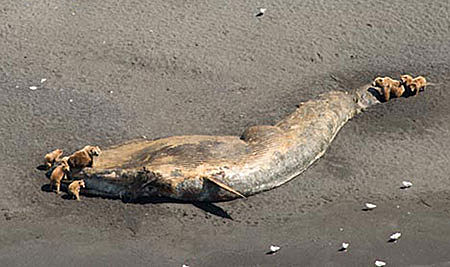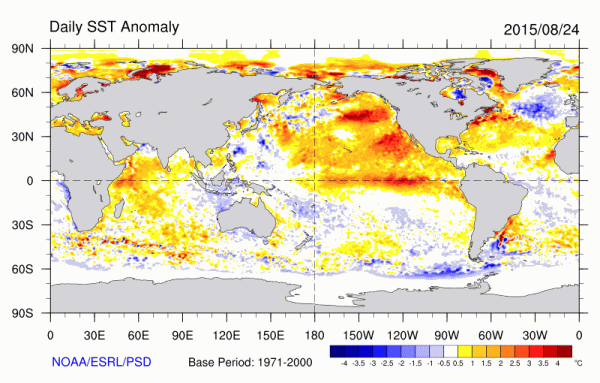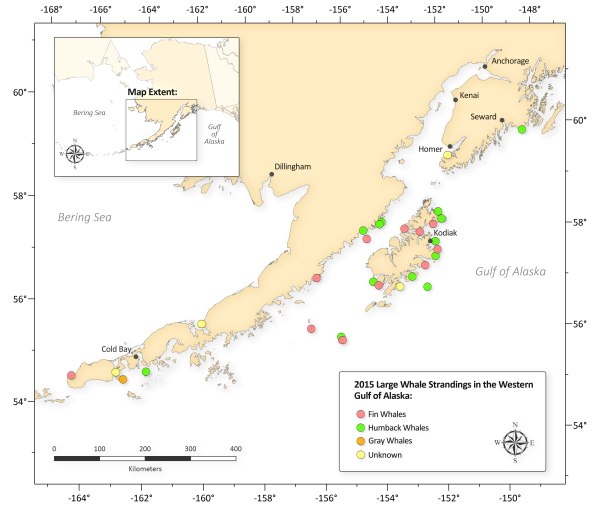Yes, the blob and the algal bloom - but, not only.
Why do people inisist on looking for one single cause when the cause is sytemic?
Mass Whale Death in Northeastern Pacific — Hot Blob’s Record Algae Bloom to Blame?
24 August, 2015
Something
lurking in the Northeastern Pacific is killing off the graceful
giants of the world’s oceans. For since May of 2015 30 large whales
have been discovered dead — their bloated and decaying bodies
washed up on Alaskan shores. It’s an unusual mortality event
featuring a death rate of nearly 400 percent above the average. So
far, scientists don’t yet have a culprit. But there is a prime
suspect and it’s one that’s linked to climate change.
*
* * * * *
(Bears
consume the carcass of a beached finback whale on the Alaskan
coastline. Image source: NOAA.)
This
month the US government declared an ‘unusual mortality event’ after
it was confirmed that 30 large whales including 11 finback whales, 14
humpback whales, one gray whale and four other whales so bad off it
that spotters where unable to identify the bodies by type were found
dead. For large whales, whose numbers tend to be low due to size, low
birth rates, and dietary requirements, that’s a very rapid
mortality rate. As a comparison, all
of 2014 only featured four large whale deaths in the Gulf of Alaska.
“NOAA Fisheries scientists and partners are very concerned about the large number of whales stranding in the western Gulf of Alaska in recent months… To date, this brings the large whale strandings for this region to almost three times the historical average.”
Hot
Blob’s Record Algae Bloom Suspected
Starting
an official investigation of this odd large marine mammal mortality
event shows that scientists are somewhat baffled about what could
have caused the tragic deaths of these majestic creatures. But the
scientists’ investigation is not absent a suspect. For the
emergence of extraordinarily warm ocean water in a region where these
whales live has been linked to a number of mass sea creature die off.
This
area — an expansive zone of 1 to 5 degree Celsius hotter than
average surface waters — has been implicated in the mass death of
starfish, in dolphin mortality events, in sea lion mortality and
orphaning events, in sea otter deaths, in salmon deaths, and in the
mass death of crabs and shellfish (see “Starving
Sea Lion Pups and Liquified Starfish” and
“Hot
Pacific Ocean Runs Bloody“).
(A
combination of factors related to human-caused climate change have
forced the Northeastern Pacific into a period of record warmth.
First, sea ice recession in the Arctic has enabled the formation of
warm ridges in the Jet Stream over this region. Second, ocean waters
are globally hotter than they’ve been in at least 135 years. Third,
a switch to positive PDO and El Nino in the Pacific has unlocked an
unprecedented degree of ocean heat forced into Pacific waters by
record strong trade winds throughout the 2000s. As a result, the
typical positive PDO signal is amplified. In other words, as Dr.
Kevin Trenberth has warned time and again, deep ocean warming is
coming back to haunt us. Image source:NOAA/ESRL.)
Abnormally
warm waters fertilized by the particulate fallout from fossil fuel
based industry and climate change driven wildfires can create a host
of problems for sea life. First, the warmer waters contain lower
levels of oxygen — which reduces the range in which fish and
crustaceans can live. Hotter, lower oxygen and zero oxygen waters
also create zones and regions in which toxic microbial life
thrive.
We’ve talked a lot about the deadly hydrogen sulfide producing bacteria. But the expansive algae blooms of a warming, nutrient enriched ocean surface can produce a host of other toxins. Microcystins, Nodularins, Anatoxin-a,Cylindrospermopsins, Lyngbyatoxin-a, Saxitoxin, Lipopolysaccharides, Aplysiatoxins,BMAA, Hydrogen Sulfide Gas and Domoic Acid are just some of the toxins produced by algae and bacteria that thrive in warming waters, in low oxygen waters, or in waters that have been subject to high nutrient loading from increasing run-off and the fallout of nitrogen and particulates due to fossil fuel burning.
We’ve talked a lot about the deadly hydrogen sulfide producing bacteria. But the expansive algae blooms of a warming, nutrient enriched ocean surface can produce a host of other toxins. Microcystins, Nodularins, Anatoxin-a,Cylindrospermopsins, Lyngbyatoxin-a, Saxitoxin, Lipopolysaccharides, Aplysiatoxins,BMAA, Hydrogen Sulfide Gas and Domoic Acid are just some of the toxins produced by algae and bacteria that thrive in warming waters, in low oxygen waters, or in waters that have been subject to high nutrient loading from increasing run-off and the fallout of nitrogen and particulates due to fossil fuel burning.
In
particular, this
year’s record red tide has
resulted in an extreme outbreak of the kind of algae that produce the
deadly neurotoxin — domoic acid. And it’s this domoic acid
poisoning that many are pointing to as a possible cause of excessive
whale deaths.
(Whale
stranding locations along an abnormally warm Gulf of Alaska.
Strandings may be associated to a global warming-tied blob of hot
water in the Northeastern Pacific together with a related red tide
algae bloom impacting the region. Image source: NOAA.)
The
massive algae bloom impacting regions of the Northeast Pacific
threatens whales in a number of ways. First, the whales swim in the
algae-filled waters. So the toxin is a part of their environment. It
thus becomes unavoidable. The toxin concentrates in the bodies of the
tiny sea creatures upon which the whales feed — planktonic life
forms that, in their turn, feed on the toxin-laden algae. As domoic
acid moves up the food chain, it bio-magnifies — becoming more
concentrated. And since whales must consume prodigious volumes of
small sea life to survive, the opportunity for biomagnification of
toxins in whales is great.
Biomagnification of domoic acid is also a threat to human beings. And it is for this reason that the US Fisheries Services have curtailed the consumption of West Coast shellfish, which can contain high concentrations of domoic acid from 2015’s record red tide.
Conditions
in Context — Deadly Waters
Mass
whale deaths and strandings along the Alaskan coastline have, over
recent weeks, garnered a great deal of attention from the public.
However, these strandings and deaths do not occur in isolation. The
tragic and freakish mortality events are happening in a region of
abnormally hot water. A region of hot water that scientists have
linked to human-forced climate change. An area in which numerous
other mass sea creature deaths have occurred.
The
region features low oxygen waters. Waters infected by deadly microbes
that have liquified starfish, crabs, and sea cucumbers. And waters
that now feature the largest red tide — a massive bloom of toxic
algae — on record. It should be very clear from all these related
events occurring within the same region of abnormally hot water that
a warming ocean is an increasingly deadly ocean. And if we are to
have any hope of halting these events, we should look to cessation of
fossil fuel burning and related human forced warming of the Earth
System as rapidly as possible.
Links:
Hat
Tip to Colorado Bob
Hat
Tip to Andy in San Diego
(Please
support public, non-special interest based, science like the
fantastic efforts conducted by the fisheries and ocean researchers at
NOAA.)



You can not be serious ?
ReplyDeleteThey are dying of starvation the Ocean is broken.
The ecosystem is collapsing.